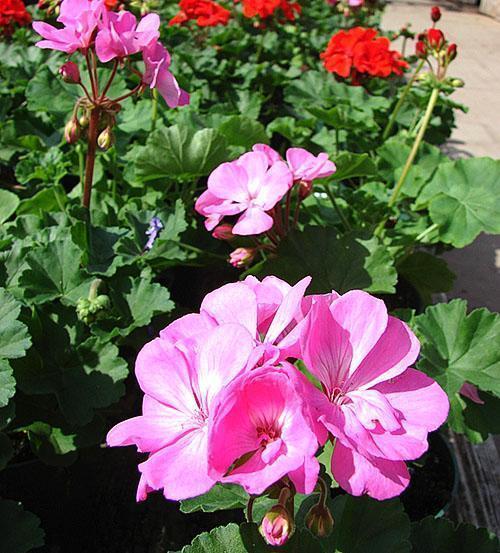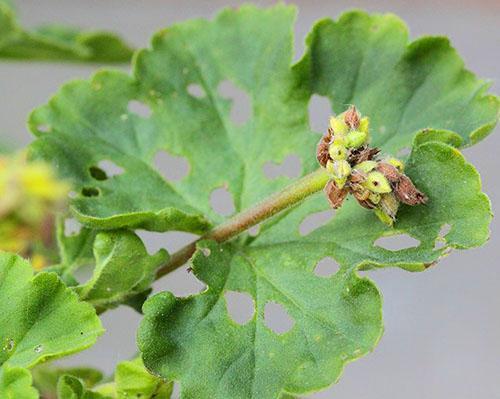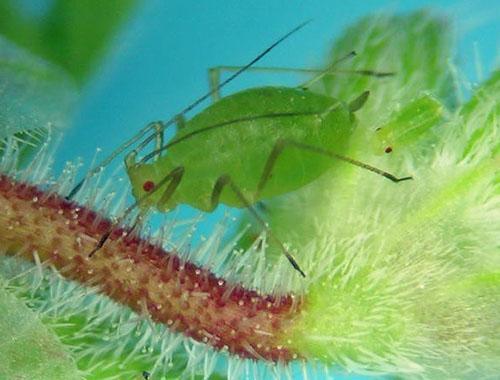What leads to yellowing of pelargonium foliage and how to help the plant?
 From spring to autumn, grown as indoor and garden plants, pelargoniums delight owners with lush inflorescence caps, endure all the hardships and grow well, requiring only a little attention and simple care. But sometimes lovers of indoor flowers complain that pelargonium loses its attractiveness, refuses to bloom, and its leaves turn yellow and dry out. What can cause this plant behavior? Why do pelargonium leaves turn yellow?
From spring to autumn, grown as indoor and garden plants, pelargoniums delight owners with lush inflorescence caps, endure all the hardships and grow well, requiring only a little attention and simple care. But sometimes lovers of indoor flowers complain that pelargonium loses its attractiveness, refuses to bloom, and its leaves turn yellow and dry out. What can cause this plant behavior? Why do pelargonium leaves turn yellow?
Care errors leading to yellowing of pelargonium leaves

- A pot too cramped for a plant, in which the roots have already occupied the entire volume intended for them, and the pelargonium lacks moisture and nutrition.
- Scarce watering, which does not provide the plant's need for moisture and leads to yellowing of the edges, and then drying of the leaves.
- Excessive soil moisture can lead to more serious consequences - to decay and loss of the root system. And in this case, the leaves of pelargonium turn yellow when the problem takes a serious turn.
- The yellow edges of especially adult leaves are a sign for the grower that pelargonium needs more intensive fertilizing, and the bush should be fertilized not only with potassium, nitrogen and phosphorus, but also with microelements after foliar feeding.
 No less dangerous for pelargoniums are insect pests that parasitize both the green part of the plant and the soil.
No less dangerous for pelargoniums are insect pests that parasitize both the green part of the plant and the soil.
Geraniums, which are grown in the garden or in balcony boxes in the summer, are most often affected by insects.
Under these conditions, on the back of the foliage and in the axils, you can find aphids, thrips, feeding on plant juices and becoming one of the reasons why the leaves turn yellow on pelargonium. In the garden, in areas with heavy, moist soil, the juicy stems of pelargonium attract slugs. Foliage and inflorescences suffer from caterpillars and leaf rollers.
Terrestrial insect control products include manual collection of pests and treatment of the plant with specialized insecticides. It is more difficult if pelargonium has been attacked by nematodes living in the ground. In this case, the plant weakens, withers, its foliage becomes smaller, and nodule formations with parasite cysts are noticeable on the roots. In order to prevent the pest from reaching pelargoniums, plants are planted only in disinfected soil. The same measure will help reduce the risk of infection of bushes with diseases of a bacterial, viral and fungal nature that are dangerous for pelargoniums.
Risk Factors Weakening Pelargonium
 In addition to poor-quality soil, the spread of diseases is facilitated by:
In addition to poor-quality soil, the spread of diseases is facilitated by:
- excessive density or poverty of the soil;
- lack of light and air with excessive planting density;
- the use of pesticides and herbicides;
- acidic environment, which does not allow the plant to receive the proper amount of nutrients and minerals;
- excess nitrogen in the applied fertilizers;
- damage to the root system and the green part of pelargonium, for example, after transplantation.
All these factors weaken plants, which become easy prey for both pests and various diseases.What diseases do pelargonium have, and how to deal with them?
Pelargonium diseases: photos and descriptions
If pelargonium reacts very sharply and quickly to violations of the growing conditions and the appearance of pests, then the diseases at the first stages are latent and do not make themselves felt for a long time.
Gray rot of pelargonium
 As a result of plant infection with the fungus Botrytis cinerea, the leaves, tops of the stems and inflorescences are covered with gray spots covered with a kind of fluff. At the same time, the disease of pelargonium, as in the photo, is capable of infecting a flower at various stages of development and in the stage of flowering and during dormancy. In place of the spots, dead tissue areas appear, which are clearly distinguishable on the leaves due to brown concentric rings along the border of the fungus.
As a result of plant infection with the fungus Botrytis cinerea, the leaves, tops of the stems and inflorescences are covered with gray spots covered with a kind of fluff. At the same time, the disease of pelargonium, as in the photo, is capable of infecting a flower at various stages of development and in the stage of flowering and during dormancy. In place of the spots, dead tissue areas appear, which are clearly distinguishable on the leaves due to brown concentric rings along the border of the fungus.
 Under the influence of the disease, as in the photo, pelargoniums shed their buds, from which the spores of the fungus fall on the foliage and the soil surface. Unless urgent action is taken, the spread of gray rot does not end until the shoot decays. The development of the disease is promoted by high humidity and inadequate care measures.
Under the influence of the disease, as in the photo, pelargoniums shed their buds, from which the spores of the fungus fall on the foliage and the soil surface. Unless urgent action is taken, the spread of gray rot does not end until the shoot decays. The development of the disease is promoted by high humidity and inadequate care measures.
Root rot or "black leg"
 Rotting of the lower part of the stem and part of the root system, which provokes the spread of harmful fungi Pythium and Rhizoctonia from the side for the grower, looks like:
Rotting of the lower part of the stem and part of the root system, which provokes the spread of harmful fungi Pythium and Rhizoctonia from the side for the grower, looks like:
- yellowing of pelargonium leaves;
- wilting of shoots;
- weakening of the plant;
- suspension of its growth.
 The propagation of fungi causes an annular lesion of the stem at the ground level, on which traces of gray or whitish bloom are noticeable at high humidity. The tissues quickly change their structure, get wet, exfoliate, and all parts of the plant above the place of decay lose their ability to receive moisture and nutrition.
The propagation of fungi causes an annular lesion of the stem at the ground level, on which traces of gray or whitish bloom are noticeable at high humidity. The tissues quickly change their structure, get wet, exfoliate, and all parts of the plant above the place of decay lose their ability to receive moisture and nutrition.
Damaged roots become deformed, brown, runny and necrotic. From the disease, as in the photo, pelargoniums often suffer at a young age. Cuttings that are in an overly humid dense environment are especially at risk of disease. The plant, as a result of fungal attack, is quickly weaker and dies.
Pelargonium bacterial disease or gommosis
Hommosis or bacterial leaf spot is accompanied not only by a change in the color of the foliage, but also by rotting and wilting of the stems.
 Pelargonium disease, as in the photo, becomes quickly apparent and is determined by the yellowness of the leaves and brown spots between the veins, and is caused by the pathogenic bacteria Xanthomonas campestris. The first signs can be seen on the back of the leaf plates, and as the disease develops, the edges of the leaves dry out, the veins turn black.
Pelargonium disease, as in the photo, becomes quickly apparent and is determined by the yellowness of the leaves and brown spots between the veins, and is caused by the pathogenic bacteria Xanthomonas campestris. The first signs can be seen on the back of the leaf plates, and as the disease develops, the edges of the leaves dry out, the veins turn black.
 When the infection becomes all-encompassing, the pelargonium plant withers, the shoots gradually die off. Blackening no longer affects parts of the leaves, but whole stems. In contrast to the "black leg", the rot is dry in this case. The difficulty in diagnosing bacterial spotting is that this pelargonium disease has common features with insect damage to plants.
When the infection becomes all-encompassing, the pelargonium plant withers, the shoots gradually die off. Blackening no longer affects parts of the leaves, but whole stems. In contrast to the "black leg", the rot is dry in this case. The difficulty in diagnosing bacterial spotting is that this pelargonium disease has common features with insect damage to plants.
Mosaic spot on pelargonium leaves
Various variants of mosaic disease are very common on pelargoniums, especially if the plants are grown crowded and with high humidity.
 This sometimes happens in the greenhouses of flower farms, from where flowering crops fall on the windowsills of ordinary amateurs.
This sometimes happens in the greenhouses of flower farms, from where flowering crops fall on the windowsills of ordinary amateurs.
Pelargonium leaf rust
 Brown or reddish traces of rust on the leaves of pelargonium are not traces of irrigation with poor-quality water, but the result of the activity of the fungi Puccinia pelargonii-zonalis.
Brown or reddish traces of rust on the leaves of pelargonium are not traces of irrigation with poor-quality water, but the result of the activity of the fungi Puccinia pelargonii-zonalis.
From the outside, the picture of the disease looks as if the foliage of pelargonium turns yellow, but if you look at the back side, you can clearly distinguish pads with ripening spores, which, having escaped to freedom, form the next wave of infection. If the disease becomes systemic, the leaves of pelargonium turn yellow completely, then fall off, and the infection spreads to the stems.
Alternaria and cercosporosis
 With both of these diseases, grayish or brown spots on the leaves are noted on pelargonium plants, the tissue inside which dries up, cracks and crumbles. The harmful fungi, the sources of the problem, settle on the back of mostly old foliage, but then the pelargonium disease, in the photo, spreads up the stems. The serious nature of the disease is indicated by the clarification of the color of the leaf plates and the loss of leaves.
With both of these diseases, grayish or brown spots on the leaves are noted on pelargonium plants, the tissue inside which dries up, cracks and crumbles. The harmful fungi, the sources of the problem, settle on the back of mostly old foliage, but then the pelargonium disease, in the photo, spreads up the stems. The serious nature of the disease is indicated by the clarification of the color of the leaf plates and the loss of leaves.
Pelargonium plant edema
 Yellowness and lightening of the foliage can also indicate edema that occurs with excessive watering during periods of low temperature, cloudy weather and under other conditions unfavorable for the growth of pelargonium.
Yellowness and lightening of the foliage can also indicate edema that occurs with excessive watering during periods of low temperature, cloudy weather and under other conditions unfavorable for the growth of pelargonium.
As chlorosis spots develop on the back of the leaf, the grower can notice their filling with moisture, then the formations coarse, and their tissues acquire the properties of cork. This is why the leaves of pelargonium turn yellow and die. The disease is especially dangerous for ivy pelargoniums and their hybrids.
How to deal with pelargonium diseases?
 Already from the description and photo, it becomes clear how dangerous the diseases of pelargonium are for plants, but how to deal with them at home or garden?
Already from the description and photo, it becomes clear how dangerous the diseases of pelargonium are for plants, but how to deal with them at home or garden?
All basic measures to combat bacterial and fungal diseases are based on competent care and prevention.
Having created comfortable conditions for pelargoniums, you can reliably protect them from any pests and parasitic microorganisms:
- The soil for pelargoniums should not be dense and excessively moist.
- The content of nutrients in the soil should fully cover the needs of the plant and be balanced.
- An excess of nitrogen in the soil is not the best way for the growth of pelargonium.
- The plant needs good drainage so that the water does not stagnate and does not provoke the development of root rot.
- Pelargoniums do not like top watering and moisture on the leaves.
- Density of plantings must not be allowed, otherwise the plants receive less oxygen, the soil is not ventilated.
- For reproduction, only benign healthy material is taken.
- The soil under the bushes is regularly cleaned of plant debris, weeds, loosened and mulched.
If pelargonium shows signs of one or another disease, it is no longer worthwhile to limit yourself to preventive measures. In this case, diseases of pelargonium should be dealt with using existing fungicides and other special means.